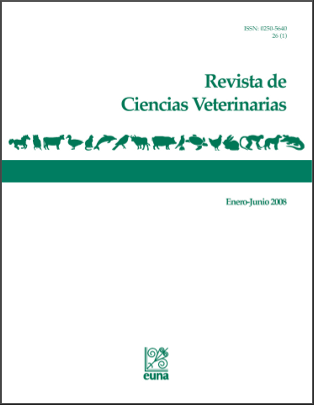Diagnosis and control procedures of the parasites of canines and felines in 50 clinics in the metropolitan area of Costa Rica
Keywords:
gastrointestinal parasites, dogs, cats, fecal analysis, deworming protocols.Abstract
In order to know current diagnosis and control procedures for gastrointestinal parasites (GIP) in canines and felines50 veterinarians working in the great metropolitan area from Costa Rica were interviewed. According to clinicians,GIP vary from very frequent (50.0%) to frequent (44%), and those considered most prevalent are: Ancylostomatids(82.0%), Toxocara sp. (80.0%), Dypilidium caninum (72.0%), Giardia sp. (70.0%), Coccidia (62.0%), Trichuris vulpis(30.0%), Capillaria sp. (2.0%) and Strongyloides stercoralis (2.0%). The diagnosis of GIP is based on a combina-tion of history, clinical signs and fecal analysis (28.0%). Direct microscopy of a single fecal sample is the most useddiagnostic procedure (84.0%). Clinical signs frequently associated by these veterinarians with GIP were hemor-rhagic diarrhea (76.0%), weight loss (70.0%) and anorexia (60.0%). We identified 18 and 4 deworming protocolsfor puppies/kittens and adults, respectively. Anthelmintic drugs are mostly used prophylactically (84.0%), which isindicative that deworming are not fecal examination-based. The results underlies inadequate diagnosis and controlpractices of small animal parasites, highlighting the need for further educational efforts directed at the veterinarycommunity emphasizing interrelationships between animal, human and environmental health.Downloads
Published
How to Cite
Issue
Section
License
Licensing of articles
All articles will be published under a license:

Licencia Creative Commons Atribución-NoComercial-SinDerivadas 3.0 Costa Rica.
Access to this journal is free of charge, only the article and the journal must be cited in full.
Intellectual property rights belong to the author. Once the article has been accepted for publication, the author assigns the reproduction rights to the Journal.
Ciencias Veterinarias Journal authorizes the printing of articles and photocopies for personal use. Also, the use for educational purposes is encouraged. Especially: institutions may create links to specific articles found in the journal's server in order to make up course packages, seminars or as instructional material.
The author may place a copy of the final version on his or her server, although it is recommended that a link be maintained to the journal's server where the original article is located.
Intellectual property violations are the responsibility of the author. The company or institution that provides access to the contents, either because it acts only as a transmitter of information (for example, Internet access providers) or because it offers public server services, is not responsible.







